
 Author: Geoffrey Hamm, Sr. Automation Advisor
Author: Geoffrey Hamm, Sr. Automation Advisor
Over the years, our perception of the word “mining” has changed a lot. Whereas 20 years ago, it most likely brought about imagery of bearded prospectors in overalls trying to get rich quick (think Gus Chiggins), nowadays it may be more associated with young Crypto-conscious investors… also trying to get rich quick. “Process Mining” reinforces the application of the word as it relates to intangible assets (less gold and coal, more Bitcoin and now… process).
In 2021, IBM announced the acquisition of myInvenio, an Italian Process Mining company. This has left a lot of people asking….
Process Mining is an emerging technological approach to process discovery and improvement that tells us how our processes really work – often in stark contrast to how we think they work. Today I want to give you a quick introduction to IBM Process Mining, then discuss how it works and how it can help you.
As previously mentioned, IBM Process Mining began as an Italian start-up called myInvenio – adding Process Mining to the long list of things Italians got right, alongside food and fashion. 
The tool was originally marketed as a disruptive solution that automatically analyzed and monitored business processes and predicted future trends. Now, paired with IBM’s canon of pre-integrated technologies, the vision has expanded.
“myInvenio capabilities reveal inefficiencies, bottlenecks and tasks that can benefit from automation, to help organizations significantly reduce their operating costs and improve customer service. Simulations can be run to assess automation opportunities to measure the benefits of applying automation at the outset of the automation journey. By analyzing historical process execution data and desktop behavior, myInvenio technology can help determine where to apply RPA bots, automated decisions, AI models, and other automations to have the most impact on a business.”
“With myInvenio, IBM can help customers identify the business processes that may benefit most from automation. When myInvenio capabilities are added to existing workflow, decisions, RPA, content and capture capabilities, we’ll be able to offer customers a one-stop shop for implementing enterprise-wide intelligent automation to support digital labor, augmented workforces and automated operations. With myInvenio, I anticipate that we’ll be the first vendor to offer such a complete and integrated set of end-to-end AI-powered automation capabilities to customers. The capabilities will be part of the IBM Cloud Paks for Automation and powered by Red Hat Open Shift to run anywhere — helping customers automate their entire enterprise.”
As explicitly called out by Dinesh, Process Mining is on target to become the next big tool in the Digital Business Automation toolbox. If “Digital Business Automation” is a foreign term to you, check out this blog written by our CEO Brian French. We also recently hosted a webinar on the same topic (replay can be found here).
Based on the nature of the tech, and confirmed by these statements from IBM, it’s clear that Process Mining will play a pivotal role in the assessment and application of core Automation technologies going forward. But how exactly does it work?
Fundamentally, Process Mining analyzes business processes from event logs. If you take a second to think about it, we all interact with a multitude of systems throughout the day as we conduct our work (i.e. CRMs, ERPs, Email, etc…). Most of these systems have log files where events are recorded. They might look a little something like this:
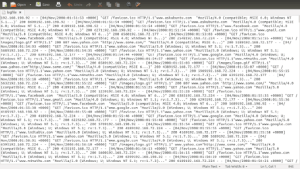
Some nice light reading, huh? NOT! These are NOT the kinds of files you want to spend your day looking through.
That being said, logs often contain valuable, untapped data… and lots of it.
IBM Process Mining consumes these log files and turns them into something we, as humans, can actually use:
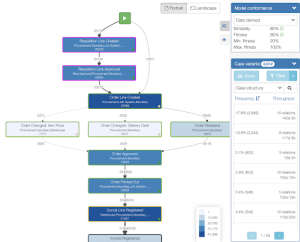 You may be wondering – what is the relationship between Process Mining and Process Modeling?
You may be wondering – what is the relationship between Process Mining and Process Modeling?Good question.
The output of Process Modeling (BPMN) can be consumed by IBM Process Mining. When consumed, we can use IBM Process Mining to tell us about our models’ conformance. To put it simply, Process Mining will tell us if our processes are actually doing what it is we think they are doing.
For IBM Process Mining to tell us that however, we must first disclose what it is we think our processes are doing (it’s Artificial Intelligence, not Artificial Mind Reading). Thus the need to consume those BPMN files. This in turn becomes our “reference model”.
Here’s a look at what the tool will generate given some log files and a reference model:
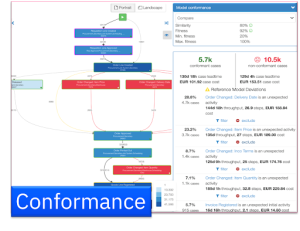
As you can see, the tool will identify conformant and non-conformant cases. In this example, what the process did and what we expected it to do were very misaligned: nearly twice as many non-conformant cases as conformant ones, and with a handful of activities we were not anticipating.
Well, first of all, it can tell you if your processes are running as expected. It can also tell you how often certain activities are happening, how long they’re taking, and how much they’re costing you:
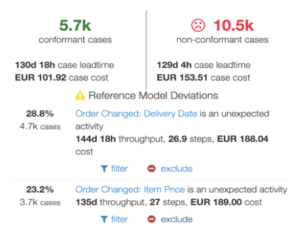
In addition to consuming process models for reference, IBM Process Mining can also generate process models for reference elsewhere. Thus, it can be used in lieu of process modeling in certain circumstances – or as a launchpad for process modeling in others.
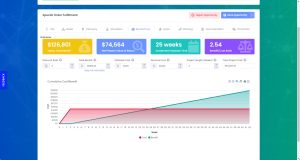 The output from IBM Process Mining can be used by Salient’s Automation Compass to take it the next level – automatically identifying automation opportunities, running simulations against different versions of the process, and even calculating ROI.
The output from IBM Process Mining can be used by Salient’s Automation Compass to take it the next level – automatically identifying automation opportunities, running simulations against different versions of the process, and even calculating ROI.
My colleague Jared Michalec wrote a great article on how Automation Compass (called DBA Sim at the time of publishing) can be used to identify and prioritize automation opportunities based on data which IBM Process Mining provides (i.e. process models, volumes, activity times, work schedules, decision outcomes, etc…)
At this point, it probably seems fairly obvious how Process Mining will play a critical role in the upfront efforts of budding Automation initiatives, but I think it will also be paramount in ongoing efforts – “checking our work”.
We can create a continuous improvement loop in which we analyze the effectiveness of our process using IBM Process Mining, improve the process using IBM Blueworks Live and Automation Compass, let the improved process run, then analyze the effectiveness of our improved process using IBM Process Mining.
Here’s a chart I made for the people who don’t like to read as much:
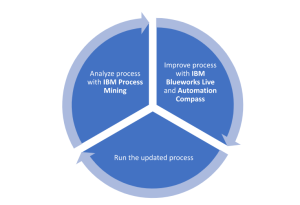
Figure 1: Continuous Improvement Loop
In the late 1840’s, rumors spread of gold in California. Almost instantaneously, the mining began. Some people struck gold, and some people struck out. Now, nearly 200 years later in the early 2020’s, the “gold” is locked inside our data. The mining has started. Undoubtedly, some organizations will strike out…
Luckily, Salient Process is uniquely positioned to help you strike [process].
So, if Process Mining is of interest to you and your organization, let’s chat!
Salient Process is a full-service digital business automation shop and proud IBM Automation business partner. To learn more about us at our website, request a free consultation with one of our expert automation advisors! We look forward to guiding you and your company along your own unique Digital Business Automation journey.